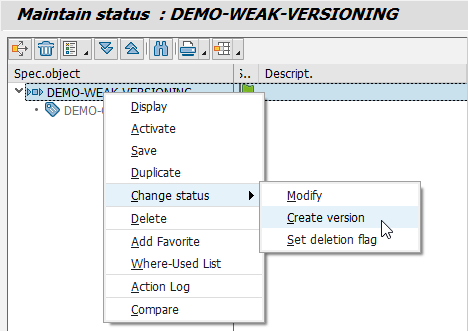When versioning the header, the entire object is versioned. This is only possible if the object and all its children have been released beforehand.
All children of the object with the highest versions are always copied to the new version of the header, except in the case of consistent versioning - regardless of the version setting on the child. Therefore, older versions of children are not considered. Therefore, no versions or successor versions of the children are created, but real copies. Therefore all children get a new specification number and the version number is set to "1". The OGUID and PREVOGUID of the new child is the GUID of the new header. In addition, the "Valid from date" (VALIDFR) of the new child is set to the current time. The child nodes on the previous, currently versioned object, remain unchanged. In particular, the status remains set to "Released" (IZQFR).
If the header has the versioning type "Weak versioning", the OGUID and PREVOGUID of the new header are set to the GUID of the new header. In addition, the validity range of the new version is adjusted by setting the VALIDFR to the current time. When the successor version is released, the status of the previous version remains "Released" (IZQFR). In particular, the status of the previous version can be revoked.
With the next higher "versioning as copy", the status of the old header does not remain at "Released" (IZQFR) after the new version has been released but changes to "Old version" (IZQAL). The status of the previous version can no longer be undone and the node can no longer be changed subsequently.
With the next higher "Versioning as copy, consistent validity area", the validity area of the old header is additionally adjusted by setting the VALIDTO to the current time minus 1 second. Here, too, the status of the previous version can no longer be undone. The node can no longer be changed subsequently.
The consistent versioning at the header is explained in Consistent Versioning (H).
Example
In this example, versioning is performed at the header of an object with a child. The status "Released" (IZQFR) is available in the status profile. Both nodes have the versioning type "Weak versioning". If the object is released, you can select "Create version" on the header via the context menu → Change status → "Create version".
The main similarities and differences between the two versions of the header can be seen in the following text and figures. The successor version of the header has the same regulation number as the previous version. The version number has been increased by one. The validity area in the form of the VALIDFR has been adjusted to the current time.
The following screen shows the header information of the object that was versioned:
The following screen shows the header information of the object created by the versioning/successor version:
The main similarities and differences between the two versions of the child can be seen in the following text and figures. The successor version of the child is given a new specification number because it is a true copy. The version number is not incremented and is set to one. The validity area in the form of the VALIDFR has been adjusted to the current time.
The following screen shows the information of the child of the object that was versioned:
The following image shows the information of the child in the object created by versioning / successor version:
After the successor version of the object has been released, the status of the header of the previous version remains "Released" (IZQFR).





